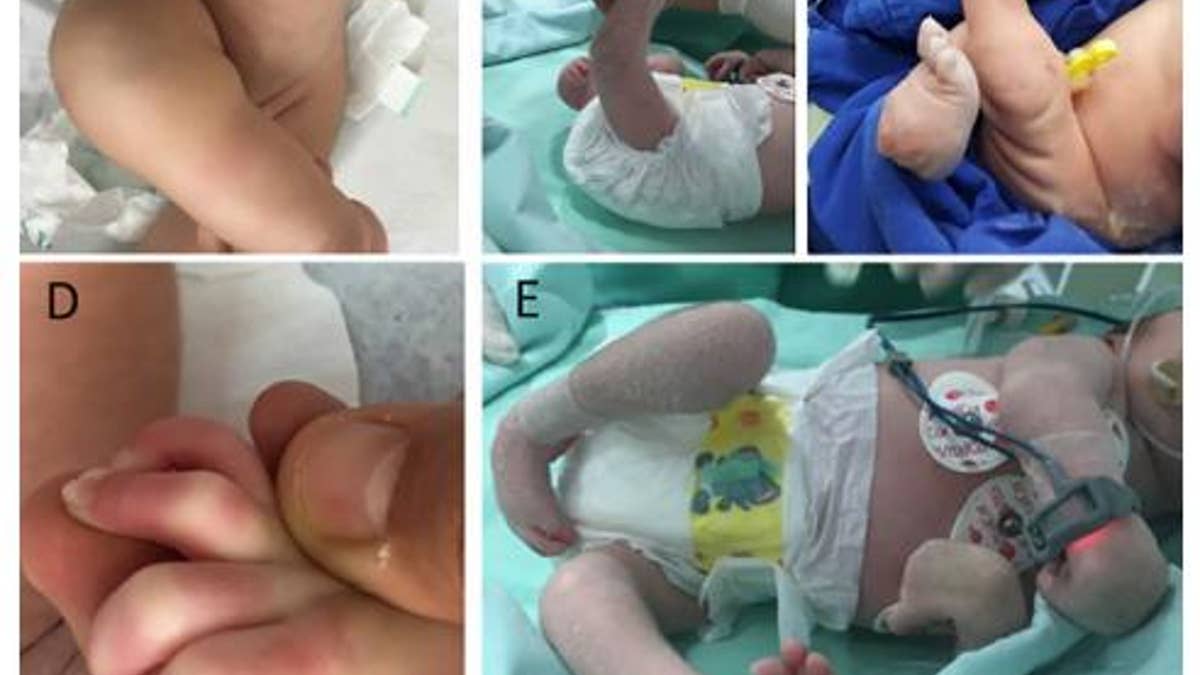
Clinical pictures of children with arthrogryposis. (The BMJ 2016)
We now know about the dangers of the Zika virus and the effect this infection can have on a developing fetus, but by no means should we consider ourselves well versed. It took many studies and thousands of reported cases for experts to conclude that the virus causes microcephaly and other severe birth defects in infants. Now, a study published Tuesday in The BMJ is helping shed light on the true extent of these possible birth defects.
Researchers focused on seven babies whose mothers were infected with Zika while pregnant. Six of the seven developed microcephaly— the most widely publicized birth defect from Zika— but six also had trouble swallowing, six had clubfoot, five had eye abnormalities, and two needed breathing and feeding tubes.
Notably, all of the babies were born with dislocated hips, a symptom of an extremely rare joint disorder clinically described as arthrogryposis. The condition causes limited joint function in children which can result in these dislocations, or “locked” limbs. Often, children with the condition have muscles around the affected joints that are thin or weak, or missing altogether. While most contractures occur in the arms and legs, the condition can also affect the child’s spine or jaw.
In addition to joint symptoms, arthrogryposis typically presents with an array of other problems that can affect the nervous system, kidneys, heart and other organs. While children can benefit from treatment, some require lifetime assistance with daily activities and may require a wheelchair.
If you look at the reported incidence of arthrogryposis in pregnancy in general, the frequency seems to be one in 3,000 babies. Typically, this is seen on ultrasound when it’s clear the baby is unable to hyperextend their extremities.
Study authors said the abnormalities could be a result of Zika’s effect on the developing fetus’ motor neurons, which control the contraction and relaxation of muscles. The research was observational, so it’s unclear whether Zika was a direct cause of arthrogryposis, but we should be cognizant of the evidence that it likely was.
All of the children showed signs of brain calcification, which is evidence of past damage likely caused by the virus. All of the children’s mothers had either documented Zika infections, a Zika-like rash during pregnancy, or had given birth to a baby with an abnormally small head.
Where there’s smoke, there’s fire.
What this study is ultimately telling us is that the Zika story is not ending anytime soon. The toxic effect that this infection seems to have as it relates to neurological tissue seems to be creating other conditions that we in the health care field need to be aware of.
Now, there are conditions that could also lead to arthrogryposis that have nothing to do with Zika. A common example is when there is decreased amniotic fluid around the fetus, limiting the space where the baby can grow— therefore preventing the baby from hyperextending his or her limbs, and moving about freely during the course of the mother’s pregnancy.
There are some genetic disorders that have also been linked with this abnormal contracture of the hands and feet, and there are central nervous system abnormalities that have been associated with arthrogryposis— and they are usually very specific to that condition. Let us also not forget that there are other infectious diseases like toxoplasmosis and cytomegalovirus (CMV) that have been linked with intracranial abnormalities, which can lead to a vast array of neurological effects.
But this story of the Zika virus during pregnancy, and the effects it can have on children’s development, is particularly very concerning to me. I am extremely proud of the fact that the medical community is coming together on this issue. As National Institute of Allergy and Infectious Diseases Director Dr. Anthony Fauci stated in the Zika special we aired here on Fox, when he saw some of the effects that some newborns were having in South America, he called for all hands on deck to tackle this problem.
I just hope that physicians who practice obstetrics and gynecology continue to become well informed as to how to screen a pregnant woman exposed to Zika and that the federal government, along with the private sector, develops vaccines that can come to market to protect women and children.
